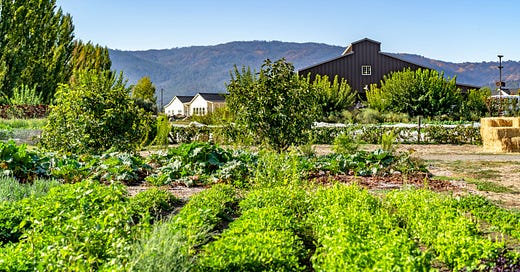When the European explorers first came to the New World, they were interested in native agriculture. Famine was a familiar presence in the old country, and even when times were good the ordinary person’s diet there was neither varied nor abundant.
The Europeans quickly noticed the “Three Sisters” method of planting crops. Instead of growing a single crop per field, Native Americans planted beans, corn and squash together. These three food crops were the cornerstones of native cookery. The beans used the corn stalks as a support and supplied nitrogen to the soil. The squash kept the roots of the corn and beans cool, and its large prickly leaves helped retain soil moisture and repel vermin.
This approach is an early example of companion planting, or the grouping of different yet compatible crops. Today many gardeners plant beans as a cover crop to add nitrogen to the soil. Cover crops also loosen soil and act as a green mulch that discourages weeds. They are generally planted in the winter.
I have heard several claims about the benefits of companion planting. Some say that basil grown next to a tomato plant will give the tomatoes a more intense flavor. I tried the combination last year, and while I didn’t get basil-flavored tomatoes, I did have lush basil plants that kept the roots of my tomatoes cool. The basil also attracted pollinators, which helped produce an abundant crop of cherry tomatoes. This paired planting was a success.
The University of California Master Gardener Handbook says no research supports the idea that certain flowers and herbs repel insects. However, according to the handbook, “adding certain flowering plants to a garden can increase floral and nectar sources for beneficial insects that provide biological control of pest insects.”
The claims about marigolds’ ability to repel insects have the allure of folklore, but it is the marigolds’ attractiveness to ladybugs, which feed on aphids, that makes it an antidote to insect pests. (Note: marigolds do contain thiophene, which discourages root nematodes.) Heavily scented herbs can disorient pests — think lavender, rosemary, salvia and scented geranium. This is a good reason to plant them next to vegetables. Not only are they beautiful, but they also function as decoys that can derail insect pests.
Many years ago, I let a lemon balm jump out of its pot. Now keeping it under control is a major preoccupation, and sometimes I give up. I noticed that my rose, which is usually plagued with aphids, has no such problem this year. That’s possibly because it is next to a vigorous stand of lemon balm. The lemon balm scent obscures the rose fragrance, and the aphids have passed it by this year.
One type of plant that many insect pests avoid because of its scent is the onion family. Onions, garlic, chives and chubby leeks are not attractive to insects, so plant them near your vegetables and flowers.
You might want to put in a “trap crop,” a plant that steers pests away from a more desirable crop. For example, a few radishes can attract cucumber beetles and keep them away from your cucumbers. Radishes can lure pests away from eggplants and tomatoes, too. Plant them a few weeks before your main crop. Since the pests only consume the radish leaves, you can still eat the radish root.
Where you plant the trap crop depends on how mobile the pest is. If you are targeting small insects that don’t go far, such as aphids, plant the trap crop next to the vegetables you are trying to protect. If the pest is more mobile, like the cabbage worm, plant the trap crop farther away.
There is no law that says your vegetables, fruits and flowers need to be planted in straight rows. You can plant them in any pattern as long as they get the necessary sun or shade. An irregular shape is eye-catching, fun and perfectly functional. One of my friends uses strawberries the way most people use flowers, as a colorful accent to her backyard. By scattering them about her yard, she minimizes the chance that a hungry animal will take them all in one foray.
When we introduce diversity into our garden, we increase the odds that our plants will thrive. As a consequence, we can reduce our dependency on synthetic pest control, which is better for the planet.
We should look at our gardens not as distinct landscapes but as part of the larger environment, with the attendant birds, bees and butterflies. By doing so we see ways to improve soil, save water, raise food and flowers, and still have a place to enjoy nature.
Today’s garden style is more relaxed, less regimented than in years past. Companion planting, with its varied textures and forms that create a true horticultural cornucopia, fits that mode.
Gardening with the masters
Join UC Master Gardeners on Saturday, June 17, from 10 a.m. to noon at OLE Health Garden, 300 Hartle Court, Napa, for this monthly workshop. Children age 5 and older are welcome with accompanying adult. Class size is limited. Register at Gardening with the Masters.
Help desk
The Master Gardener Help Desk is available to answer your garden questions on Mondays and Fridays from 10 a.m. until 1 p.m. at the University of California Cooperative Extension Office, 1710 Soscol Ave., Suite 4, Napa. Or send your questions to Master Gardeners. Include your name, address, phone number and a brief description of the problem. For best results, attach a photo of the plant. You may also leave a voicemail message with the same information at 707-253-4143.
Cindy Watter is a member of the UC Master Gardeners of Napa County.






What a great article. I really enjoyed reading it. Thank you very much. Now to get a few companion plants for my tomatoes and lemon cucumbers.